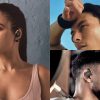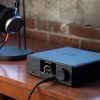Back in the dark ages when I grew up, a lot of us built crystal radio kits. It was something that our parents could get onboard with as it didn’t have the risks associated with some of the other Wiley Coyote inspired ideas most of us boys had and it actually looked like we might learn something science related in the process. We were told to follow the science back then and look where it got us. Some of us even became engineers and scientists in the process — as opposed to YouTube reviewers and TikTok dancers.

Kits varied quite a bit but all had the same basic arrangement of components; a toilet paper tube and a spoil of enamel coated magnet wire to make a coil, some form of diode, a capacitor, one or two resistors, a handful of wires, and a small brass rod for tuning.
The one part that all of the kits seemed to have in common was the earphone (singular). It was a dirty cream to medium tan colored hard plastic disc that held a driver with a clear plastic sound bore that exited the center and looked to be long enough to come out the other side if inserted too deeply. It had the impedance of a rock and fidelity slightly better than sticking your ear directly to an auto tailpipe but we had radio in our room.
This was a big deal in those days. Boomboxes and portable audio were a 1980s phenomenon so without these devices, we were forced to go to the living room and take turns listening to whatever horrible music our parents were listening to.

I’ll admit, it wasn’t long after the crystal radio that I did have a boombox; an Emerson complete with detachable speakers and even a phono input (although I don’t remember it ever being used). The model was the MM815-B, the year was 1982, and I can’t remember now whether it was a birthday or Christmas present but either way it was a great one.
The problem then was that a boombox in your room was great as long as you didn’t have someone screaming at you to turn it down because your younger siblings couldn’t fall asleep.
So again, back to headphones we go. At least it had a proper 6.3mm jack for headphones so a pair of Realistic Nova 80s appeared in my room one day (I think this was dad’s way of keeping mom and I both happy as he had been the one who thought the boombox was a good idea).

Earbuds vs. Earphones vs. IEMs
Anyway, back to my original point. Earphones today have come a very long way from that earliest cream colored brain stabber but somewhere along the way they also got split into earphones, earbuds, and in-ear monitors (IEMs). Then Apple added their own branded term AirPods and rebranded their original white wired earbuds as EarPods. Regardless of which “Pod” is in the name, they’re all earbuds.
Earphones versus earbuds is a pretty easy line to draw. If it seals the ear canal it’s an earphone, if it doesn’t it’s an earbud. Earphones and IEMs though are a bit harder to distinguish and a lot of manufacturers now call everything an IEM.
I think part of the confusion comes from the fact that near-field monitors became popular for desktop use in home office environments at roughly the same time as in-ear monitors began making waves in the mainstream so we have a tendency to try and relate the two. While they are distantly related, they are not analogues.

If you go to a live show, you’ll often notice that the main speakers are in front of the stage but that at various points around the stage there are speakers pointed back at the performers — stage monitors. Each of these monitors is tuned to provide a particular musician with the feedback he/she needs. You see the problem here right? 6 monitors with different mixes being played within 50 feet of each other are going to have a lot of bleed over not to mention the tower of speakers in front of the stage contributing even more noise to your mix. IEMs were born to replace stage monitors.

For that reason, the easiest way to identify a true in-ear monitor is by the degree of isolation it provides from the outside world. It is not enough to be somewhat isolating because you have a giant stack of Marshall amps and a stadium filled with screaming fans to compete with.

The IEM Test
There are a lot of earphones masquerading as in-ear monitors today. Do you want to know which ones truly deserve the title? Here’s an easy experiment. Get your favorite headphones, put on a rocking track and set the volume to slightly above comfortable listening level (remember simulating concert environment here). Now put the IEMs in your ears and put the headphones on over them. If you can still hear your headphones playing, they are earphones — if you can’t then it is truly an IEM.









































